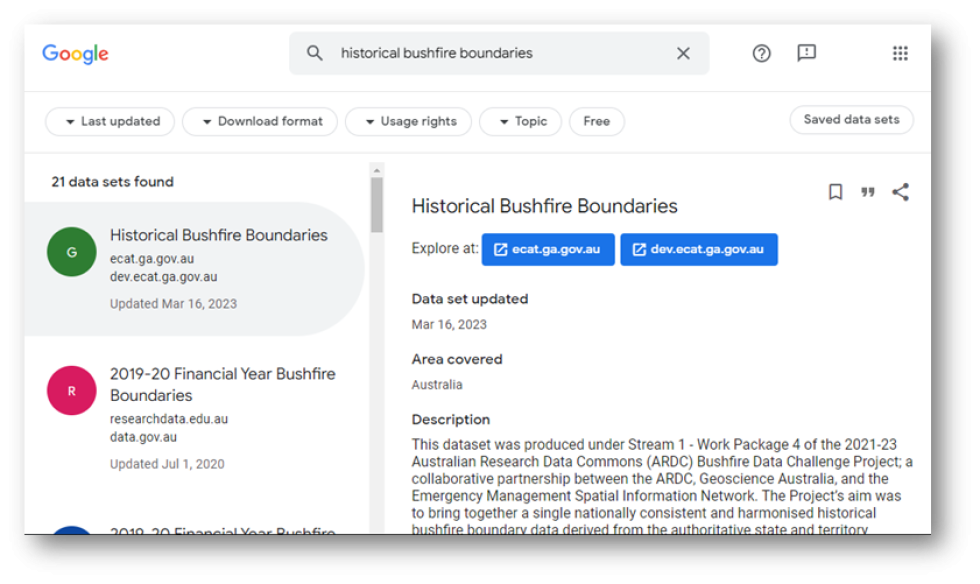Approach
Geoscience Australia publishes their data catalogue pages with Schema.org markup, using JSON-LD. They also use other kinds of metadata, including Open Graph, Twitter Cards, HTML elements and meta tags.
View one of Geoscience Australia’s marked-up data catalogue record web pages here.
You can view the source code by typing in view-source: before the URL. Here is a selection of some of the metadata you will find in the source code:
HTML title element:
<title>Historical Bushfire Boundaries</title>
Open Graph Protocol image property:
<meta property="og:image" content="https://ecat.ga.gov.au/geonetwork/srv/eng/../../images/logos/favicon.png" />
Twitter Card site property:
<meta name="twitter:site" content="Product catalogue" />
Schema.org markup (selected dataset type properties):
<script type="application/ld+json">{
"@context": "http://schema.org/",
"@type": "schema:Dataset",
"@id": "https://pid.geoscience.gov.au/dataset/ga/147763",
"includedInDataCatalog":[{"url":"https://ecat.ga.gov.au/geonetwork/srv/search#","name":""}],
"inLanguage":"eng",
"name": "Historical Bushfire Boundaries"
Outcomes
- The use of Schema.org markup makes the catalogue pages discoverable via the Google Dataset Search together with related datasets from around the world (see Figure 1)
- The use of Schema.org markup makes the pages eligible for inclusion in search engine “rich results”
- The marked-up pages do well in Google and Bing searches
- The inclusion of OGP and Twitter Card metadata properties mean the pages are presented in a uniform way on social media platforms.
The major search engines are not the only potential users of the Schema.org data markup. It is possible for anybody to use the markup in a similar way: to collate information about Geoscience Australia’s datasets and present it in a way that is useful for a particular audience. In fact, some initiatives use many more properties than Google, who only use a subset of Schema types and properties. You can see that the Geoscience catalogue has many more properties than those visible via Google Dataset Search.
Geoscience Australia can remove the Schema.org markup if they no longer wish to make their metadata available in this way for a particular resource.
What else does Geoscience Australia do well?
They:
- support the FAIR data principles: Findable, Accessible, Interoperable, Reusable
- maintain a catalogue standard which conforms to AS/NZS ISO 19115 with a Geoscience Australia metadata profile. AS/NZS ISO 19115 is an internationally adopted metadata schema for describing geographic information and services. This means their data catalogue records are more likely to be consistent and interoperable with like organisations. AS/NZS ISO 19115 specifies the metadata properties that should be used to describe geographic information and services, and also includes controlled vocabularies (code lists).
- assign persistent identifiers to digital resources, such as datasets, vocabularies and schemas.
- facilitate export of catalogue metadata in a variety of formats
- have a specific use case for Schema.org, but it is not the only kind of metadata they use on their website. Apart from social media schemas and HTML meta tags, they also use some AGLS/Dublin Core properties. If you visit their home page, and then add view-source: before the URL, you will see a number of meta tags with the prefix DC. (Dublin Core).


